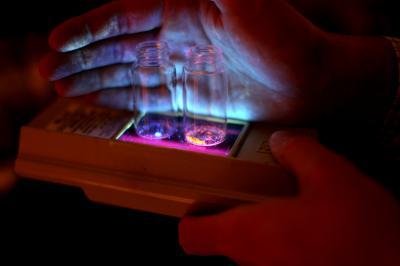Jewelry organic light-emitting materials come out to create a cheap and flexible display
According to foreign media reports, recently, University of Michigan researcher Jinsang Kim and his colleagues have developed a new organic material, a pure organic compound that emits jewel tones. Cheap, more efficient, softer display. The metal-free organic crystals produced by Kim and his colleagues show white visible light and blue, green, yellow, and orange radiation under ultraviolet light.


Organic phosphorescent materials developed by researchers at the University of Michigan
The metal-free organic crystals produced by Kim and his colleagues emit phosphorescence, a property that was once found only in inorganic compounds and organometallics. Under ultraviolet light, the crystal can exhibit white visible light, as well as blue, green, yellow, and orange radiation. By changing the chemical composition of raw materials, researchers can also make them emit different colors of light.
This new luminescent material (phosphorescent material) can be improved for current organic light emitting diodes (OLEDs) and semiconductor lighting products. Currently, bright low-power LEDs are often used to make small screens for mobile phones and digital cameras. Due to their complex manufacturing processes and high raw material costs, it is obviously not practical to use them for the manufacture of larger displays. Current LEDs are not made of 100% organic compounds and still require a small amount of precious metals.
Kim said: "In the past, pure organic materials could not produce useful phosphorescence. Therefore, we believe that this is the first example of organic matter comparable to organometallic compounds in terms of brightness and color adjustment."
In Kim's phosphorescent materials, light comes from aromatic carbonyls, an organic compound that produces phosphorescence. This new material is unique in that the aromatic carbonyl compound forms a strong halogen bond with the halogens in the crystal, enveloping the molecules tightly. This arrangement suppresses vibration and heat loss during the transition of the electron from the excited state to the ground state, thereby producing strong phosphorescence.
High-energy blue organic phosphorescence is easily produced by this new method, and it is more difficult to achieve with organic metal. Compared to similar non-organic products, organic light-emitting diodes are lighter, cheaper, and made of ceramic. However, current LEDs still contain small amounts of precious metals. The light-emitting diodes made of these new compounds do not require precious metals, so it causes a significant drop in the price of similar products, and its main components are inexpensive carbon, oxygen, chlorine, bromine and the like.
Kim said: "At present, this technology is still in its infancy, but we expect that this material will enter the commercial field in the near future, and we believe this will bring great changes to the LED and semiconductor lighting industry. Because this compound is very cheap and very easy to synthesize, the chemical composition can be adjusted to different colors."

China Area Array Sensor
Area Array Sensor,Passive Infrared Detector,Infrared Heat Detector,Infrared Area Sensor
Ningbo NaXin Perception Intelligent Technology CO., Ltd. , https://www.nicswir.com